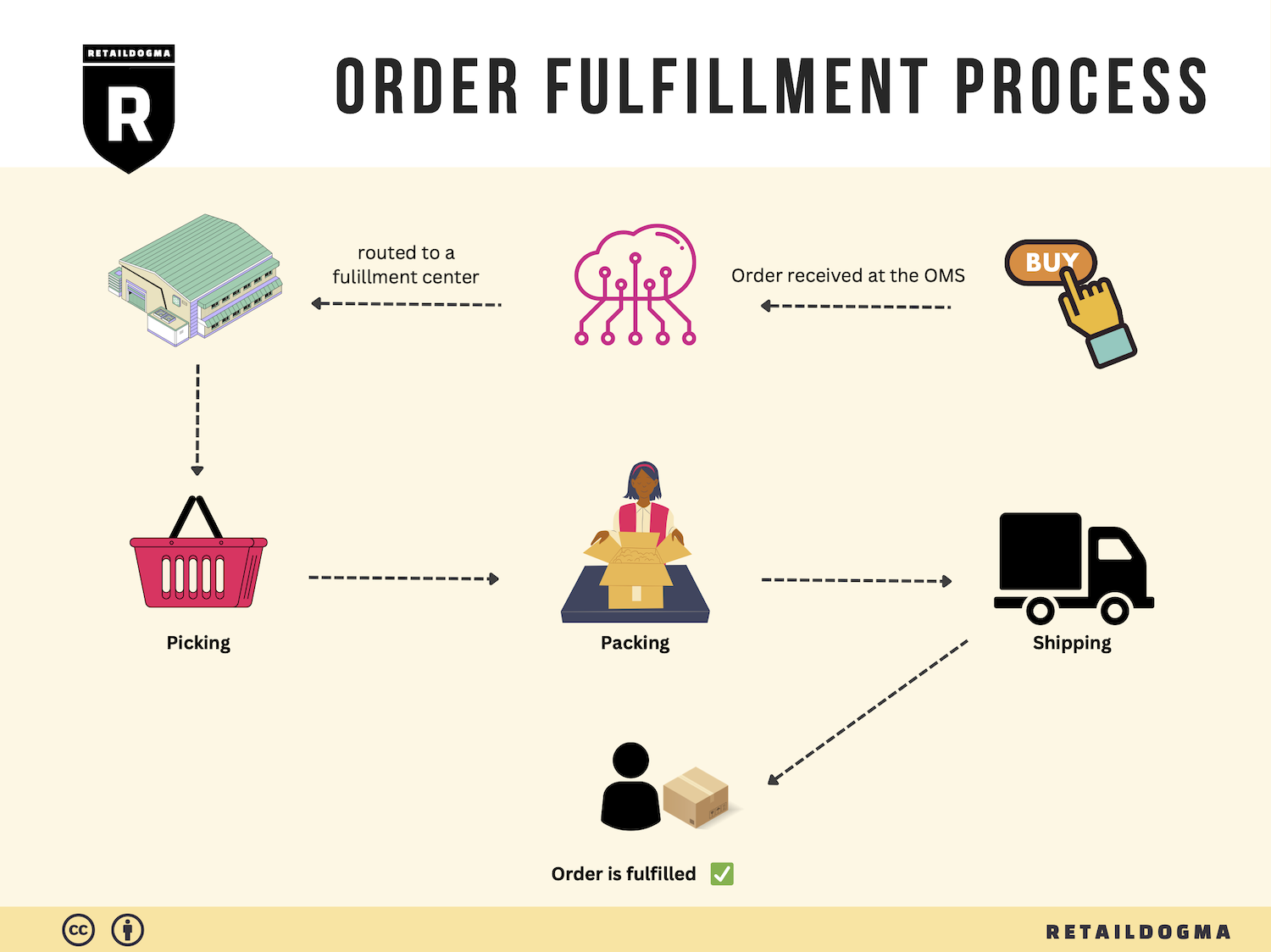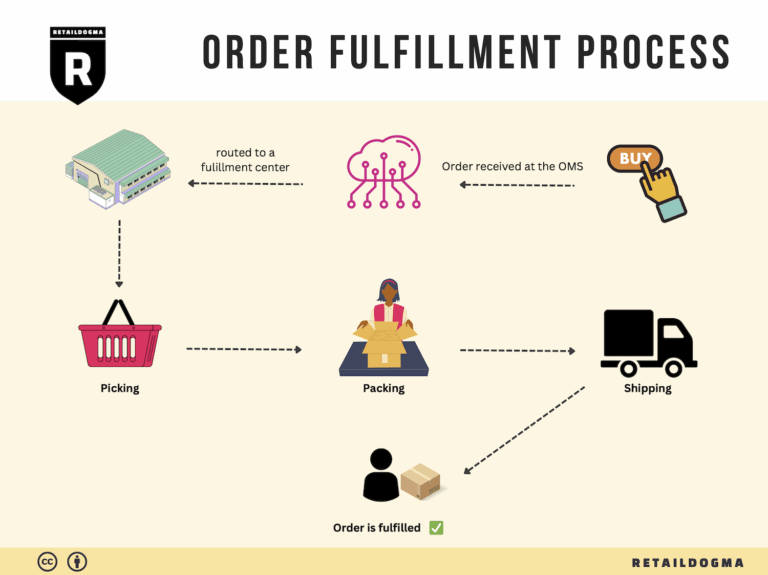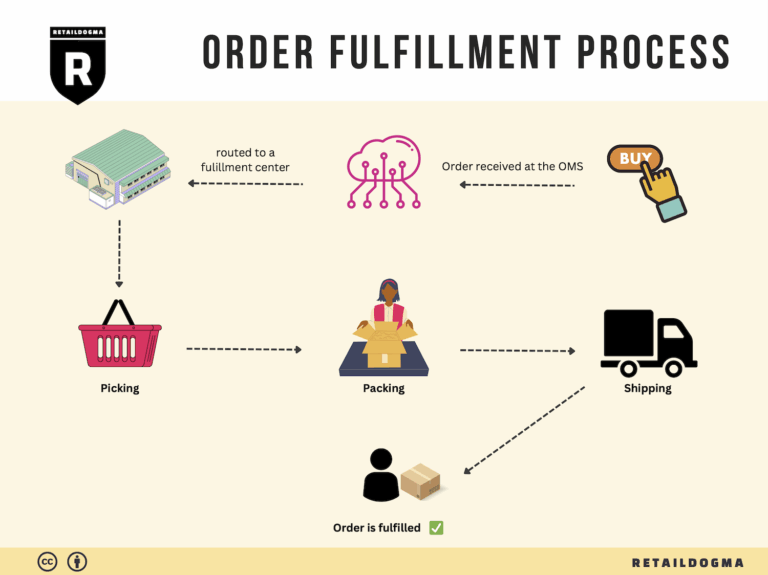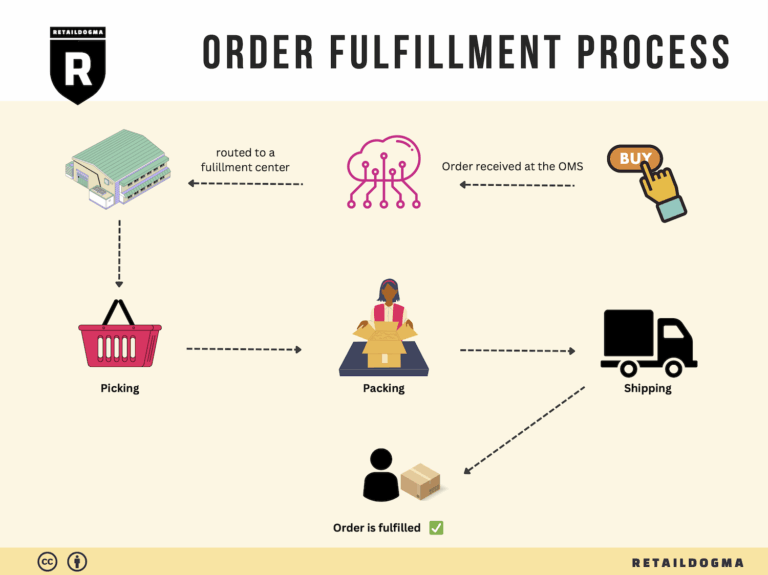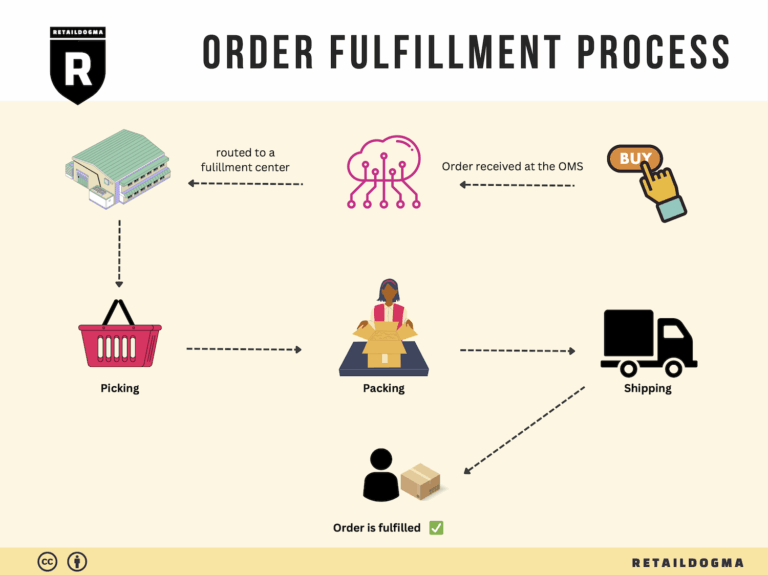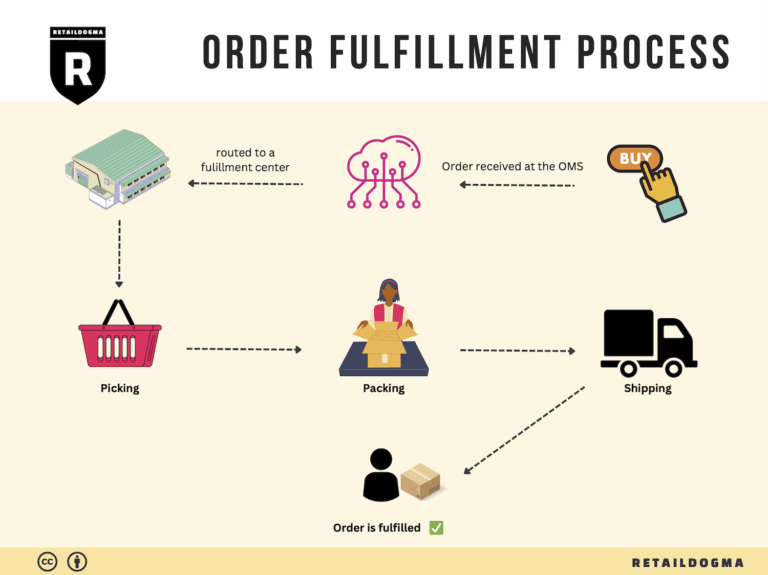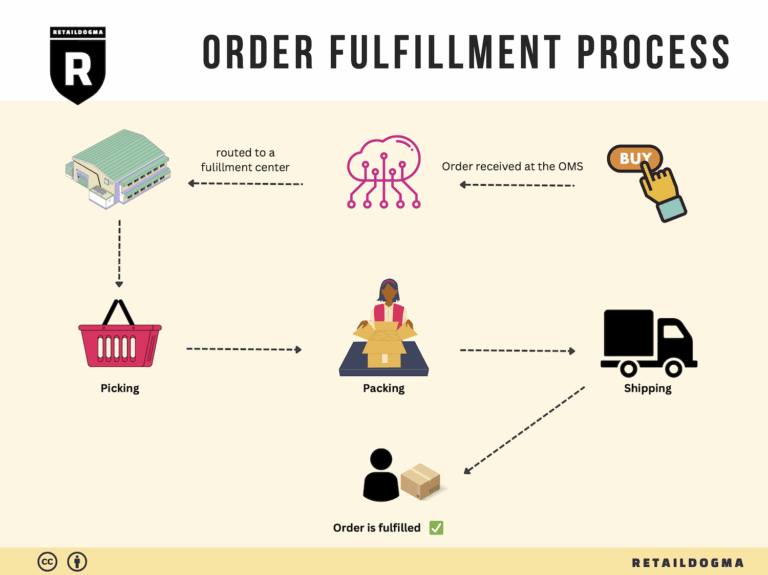Ecommerce Fulfillment Services: The Ultimate Guide (2025)
What is E-commerce Fulfillment? An Introduction for Growing Businesses
As your e-commerce business begins to grow, the excitement of increased sales can quickly be overshadowed by the daunting tasks of packing and shipping orders. Many entrepreneurs find themselves overwhelmed by the logistics of fulfilling orders, from sourcing materials to managing inventory and ensuring timely deliveries. This is where understanding e-commerce fulfillment becomes critical.
E-commerce fulfillment is simply the process of getting a product from your warehouse or fulfillment center to your customer’s doorstep. It encompasses everything from inventory management and order processing to packaging and shipping. For growing businesses, mastering this process is essential not just for customer satisfaction but also for maintaining a healthy bottom line.
This guide will delve into the various models of fulfillment that can support your growth. We will explore third-party logistics (3PL) providers, which can handle storage, packing, and shipping on your behalf, allowing you to focus on scaling your business. Additionally, we’ll discuss fulfillment by Amazon (FBA), a popular choice for many online sellers that can simplify the shipping process while leveraging Amazon’s extensive distribution network.
You will also learn about the core services involved in e-commerce fulfillment, including order management, inventory tracking, and customer service. Understanding these elements will help you streamline your operations and improve your efficiency.
Choosing the right fulfillment partner is another crucial aspect we’ll cover. We will provide practical tips on evaluating potential partners based on factors such as location, technology capabilities, scalability, and customer service. Finding a fulfillment center that aligns with your business goals can make a significant difference in your operational success.
Finally, we’ll address the important topic of pricing. Fulfillment costs can vary widely based on the services offered, volume of orders, and shipping methods used. This guide will help you understand the pricing structures involved and how to budget for fulfillment without compromising on quality.
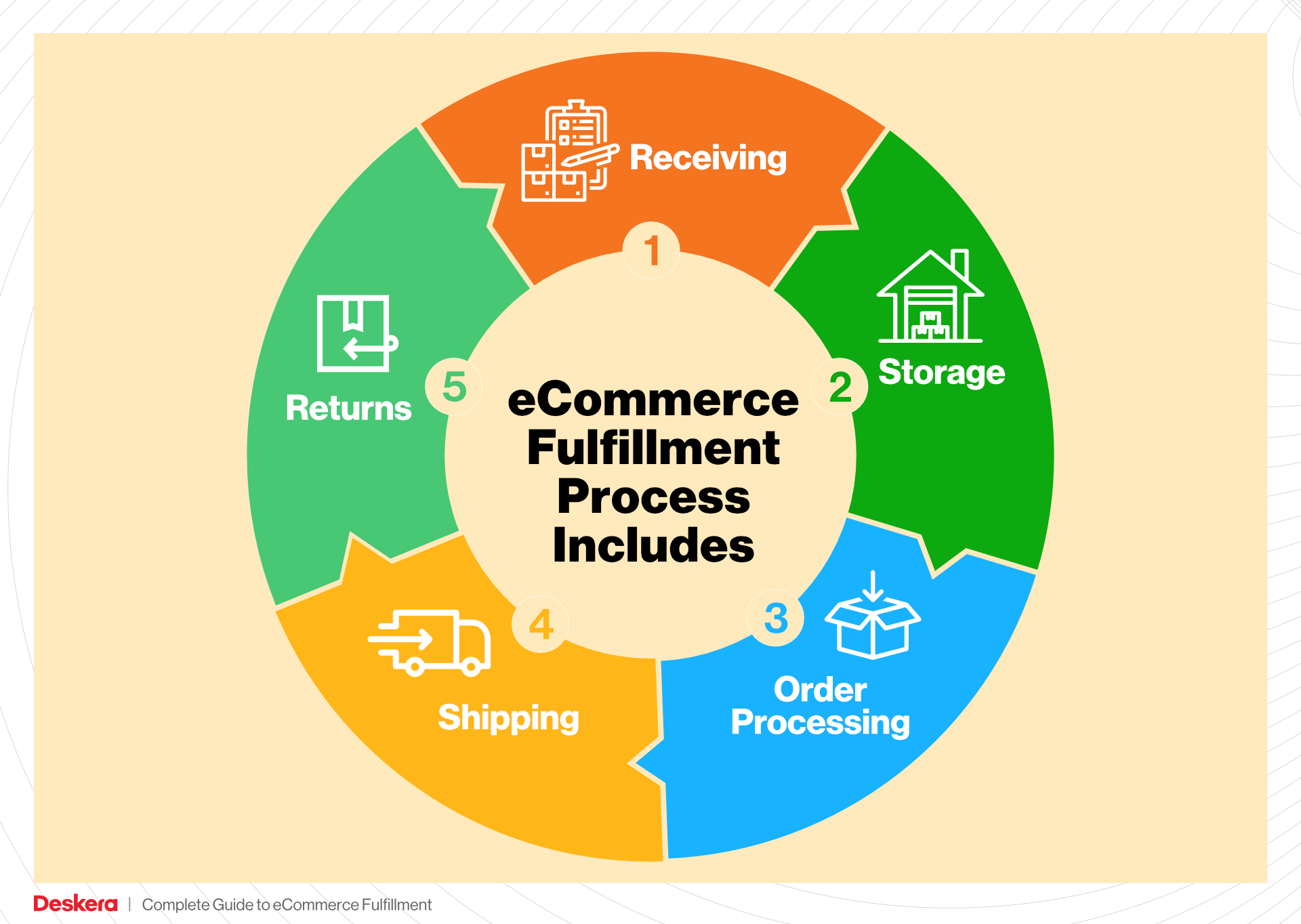
By the end of this guide, our goal is to empower you with the knowledge and tools necessary to make informed decisions about your logistics strategy. With the right fulfillment approach, you can enhance customer satisfaction, reduce operational stress, and ultimately drive the growth of your e-commerce business.
What You’ll Learn In This Guide
- What is E-commerce Fulfillment? An Introduction for Growing Businesses
- The Order Fulfillment Process: From ‘Buy’ Button to Customer’s Door
- Comparing Fulfillment Models: In-House vs. 3PL vs. Dropshipping
- A Deep Dive into Amazon FBA: Pros, Cons, and Who It’s For
- Core Services Offered by Fulfillment Centers
- How to Choose a Fulfillment Partner: A 6-Point Checklist
- Understanding Fulfillment Pricing: A Breakdown of Common Fees
- Frequently Asked Questions (FAQs) about Fulfillment
- Conclusion: Is Outsourcing Fulfillment the Right Move for Your Business?
- Important Disclaimer
The Order Fulfillment Process: From ‘Buy’ Button to Customer’s Door
1. Receiving Inventory
The first step in the order fulfillment process is receiving inventory. This involves accepting shipments of products from suppliers, which may include raw materials or finished goods. Upon arrival, the inventory is checked against the purchase orders to ensure accuracy in terms of quantity and quality. Key terms associated with this step include SKU (Stock Keeping Unit), which helps in identifying and tracking products throughout the supply chain.
Proper inventory receiving is critical for maintaining accurate stock levels. Discrepancies at this stage can lead to stockouts or overstock situations, directly affecting customer satisfaction and operational efficiency. Implementing technology such as barcode scanning can streamline this process, allowing for quick verification and data entry into inventory management systems.
2. Warehouse Storage
Once the inventory is received and verified, it is stored in the warehouse. This step involves organizing products in a manner that optimizes space and facilitates easy retrieval. Products are typically categorized based on various criteria such as size, type, or demand frequency, often utilizing a warehouse management system (WMS) to manage storage locations and inventory levels.
Efficient warehouse storage is essential for minimizing retrieval time during order picking, as it directly impacts the overall speed of fulfillment. By employing strategies such as cross-docking or utilizing vertical space, businesses can enhance their storage capabilities, reduce operational costs, and ensure that products are readily available for order fulfillment.
3. Order Picking
Order picking is the process of retrieving products from their storage locations to fulfill customer orders. This step is often guided by pick lists, which outline the items and quantities needed for each order. Order pickers may use various methods, such as single-order picking, batch picking, or zone picking, depending on the volume and complexity of the orders.
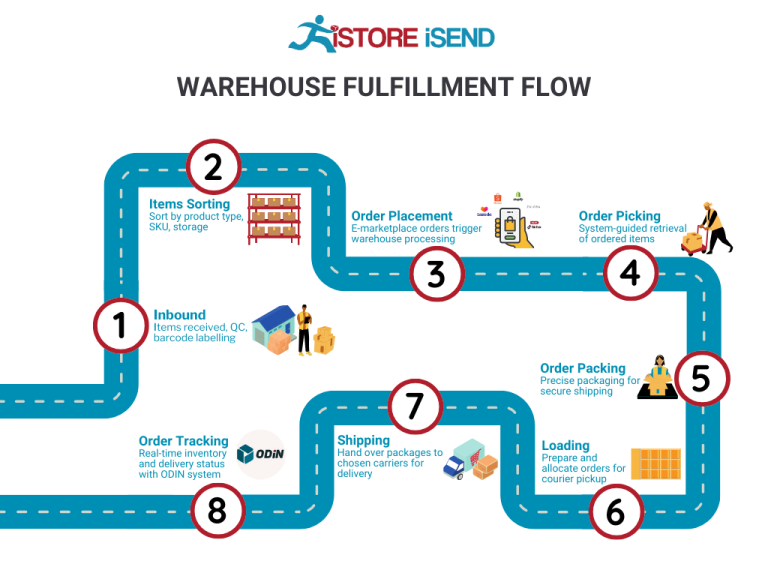
The importance of effective order picking cannot be overstated; it is a pivotal point that influences order accuracy and speed. Errors during this stage can lead to incorrect shipments, resulting in returns and dissatisfied customers. By leveraging technologies such as pick-to-light systems or mobile scanning devices, businesses can improve picking accuracy and efficiency, ultimately enhancing the customer experience.
4. Order Packing
After items have been picked, they proceed to the packing stage. This step involves securely packing the products to ensure they arrive at the customer’s location in perfect condition. Key considerations during packing include selecting appropriate packaging materials, including cushioning, and generating shipping labels. Packing slips, which detail the contents of the package, are also included for customer reference.
Order packing is vital for minimizing damage during transit and ensuring that the right items are shipped to the customer. Effective packing processes can reduce shipping costs by optimizing box sizes and materials used. Businesses should also consider sustainable packaging options to enhance their brand image and appeal to environmentally-conscious consumers.
5. Shipping & Delivery
The final step in the order fulfillment process is shipping and delivery. Once packages are packed, they are labeled and handed over to shipping carriers for delivery. Businesses must choose the appropriate shipping methods based on factors such as cost, delivery speed, and customer preferences. A crucial term in this stage is last-mile delivery, which refers to the final leg of the shipping journey from a distribution center to the customer’s door.
Efficient shipping and delivery processes are essential for customer satisfaction and retention. Timeliness and reliability can significantly impact a customer’s perception of the brand. Implementing tracking systems allows customers to monitor their orders in real-time, adding transparency to the process. Moreover, businesses should continuously evaluate their shipping partners and methods to optimize costs and improve service levels.
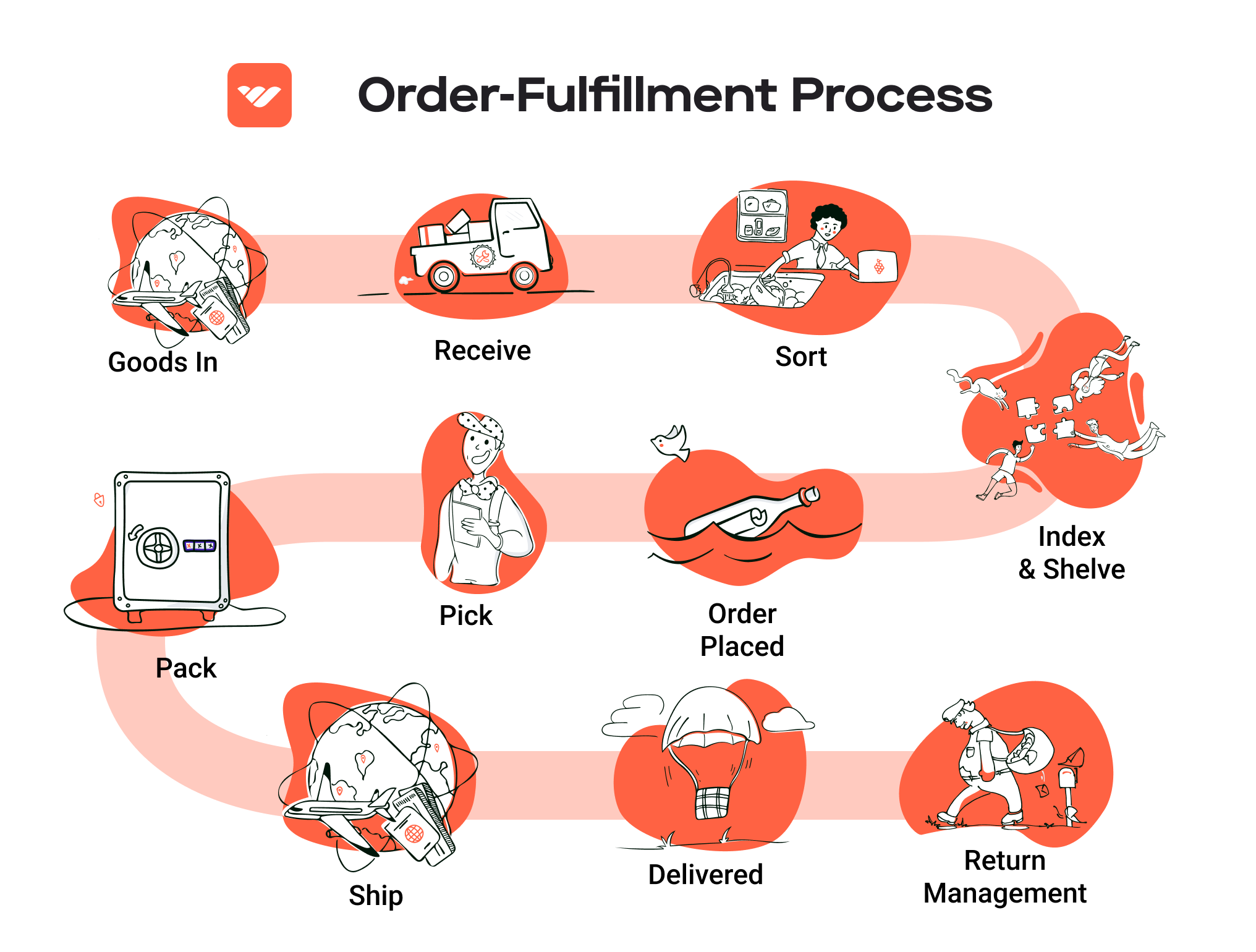
In conclusion, mastering the order fulfillment process is essential for e-commerce businesses aiming to scale their operations and enhance customer satisfaction. By focusing on each step—from receiving inventory to shipping and delivery—businesses can streamline their operations, reduce costs, and create a superior shopping experience for their customers.
Comparing Fulfillment Models: In-House vs. 3PL vs. Dropshipping
Fulfillment Model Comparison Table
| Model | Who Handles Inventory | Best For (Business Stage) | Key Advantage | Key Disadvantage |
|---|---|---|---|---|
| In-House Fulfillment | Business owns and manages | Established businesses with stable demand | Full control over inventory and processes | High overhead costs and complexity |
| Third-Party Logistics (3PL) | 3PL provider manages | Growing businesses needing scalability | Access to expertise and technology | Less control over inventory and processes |
| Dropshipping | Supplier manages inventory | Startups or businesses testing markets | Low startup costs and minimal risk | Lower profit margins and less control |
In-House Fulfillment
In-house fulfillment involves a business managing its own inventory, warehousing, and shipping processes. This model is typically best suited for established companies with a stable demand for their products. By handling fulfillment internally, businesses maintain full control over their inventory, enabling them to implement customized processes that align closely with their brand identity and customer expectations. This control extends to quality assurance, order accuracy, and the overall customer experience, which can be critical in differentiating a brand in a competitive market.
However, the in-house model comes with significant drawbacks. The initial setup can be capital-intensive, requiring investment in warehouse space, technology, and staff. Additionally, managing logistics can become complex and burdensome, particularly as order volumes increase. Businesses must also account for ongoing operational costs, including labor, rent, utilities, and maintenance. For companies looking to scale rapidly or those experiencing fluctuating demand, the in-house model may prove to be less flexible compared to other fulfillment options.
Third-Party Logistics (3PL)
Third-party logistics (3PL) providers offer a flexible solution for businesses looking to outsource their fulfillment operations. With 3PL, a specialized provider takes on the responsibility of inventory management, warehousing, and shipping, allowing businesses to focus on core activities such as marketing and product development. This model is particularly beneficial for growing businesses that require scalability without the burden of managing logistics. By leveraging the expertise and advanced technology of 3PL providers, companies can enhance their operational efficiency, reduce shipping costs, and improve delivery speed.
One of the primary advantages of using a 3PL provider is the ability to tap into their extensive network and resources, which often includes sophisticated order management systems and data analytics. However, the downside is that businesses relinquish some control over their inventory and fulfillment processes. This can lead to challenges in maintaining brand consistency and quality assurance. Additionally, relying on a third party means that businesses must carefully select a provider that aligns with their operational needs and customer expectations, as poor service from a 3PL can adversely affect customer satisfaction.
Dropshipping
Dropshipping is a fulfillment model where the retailer does not keep goods in stock but instead transfers customer orders directly to the supplier, who then ships the products to the customer. This model is particularly appealing for startups or entrepreneurs testing new markets, as it requires minimal upfront investment in inventory. With dropshipping, businesses can offer a wide range of products without the risk of unsold inventory, allowing them to pivot quickly based on market demand.
The key advantage of dropshipping is the low overhead; there’s no need for warehousing or inventory management, which significantly lowers operational costs. However, dropshipping also comes with challenges. Profit margins tend to be lower compared to traditional retail models, as suppliers often charge higher prices for their products. Additionally, businesses have limited control over inventory levels, shipping times, and product quality, which can lead to inconsistencies in customer experiences. Managing relationships with suppliers is crucial, as any delays or errors can reflect poorly on the retailer’s brand. Overall, while dropshipping offers a low-risk entry into e-commerce, it requires careful management and strategic planning to ensure profitability and customer satisfaction.
A Deep Dive into Amazon FBA: Pros, Cons, and Who It’s For
Understanding Fulfillment by Amazon (FBA)
Fulfillment by Amazon (FBA) is a service provided by Amazon that allows e-commerce sellers to store their products in Amazon’s fulfillment centers. Amazon then takes care of storage, packaging, shipping, and customer service for these products. This service is particularly appealing to entrepreneurs and businesses looking to scale their operations without the significant overhead associated with managing logistics and fulfillment in-house.
When a customer orders a product listed with FBA, Amazon handles the entire fulfillment process. This includes picking the product from the warehouse, packing it securely, shipping it to the customer, and managing any customer inquiries or returns. As a result, sellers can focus on other crucial aspects of their business, such as marketing and product development.
How FBA Works
-
Registration: Sellers need to create an Amazon seller account and register for FBA. This can be done through the Amazon Seller Central platform.
-
Product Listing: Once registered, sellers can create listings for their products. They can choose to enroll existing listings in FBA or create new ones specifically for the program.
-
Inventory Shipment: Sellers send their products to Amazon’s fulfillment centers. Amazon provides guidelines on how to package and label the products to ensure they can be processed efficiently.
-
Storage: Products are stored in Amazon’s warehouses until an order is placed. Sellers are charged storage fees based on the amount of space their inventory occupies.
-
Order Fulfillment: When a customer orders a product, Amazon takes care of picking, packing, and shipping it. The seller benefits from Amazon’s vast logistics network, ensuring timely delivery.
-
Customer Service: Amazon also handles customer service and returns, providing a seamless experience for buyers and allowing sellers to focus on other business activities.
Pros of Using FBA
1. Prime Eligibility
One of the most significant advantages of FBA is that products fulfilled by Amazon are eligible for Amazon Prime. This means they can be offered with free two-day shipping, which is a powerful incentive for customers. Prime members tend to make more purchases, leading to higher sales volumes for sellers.
2. Customer Trust
Amazon is a globally recognized brand with a strong reputation for customer service and reliability. By using FBA, sellers benefit from this trust. Customers are more likely to purchase items that are fulfilled by Amazon, knowing that they will receive their products quickly and that any issues will be handled efficiently.
3. Multi-Channel Fulfillment
FBA allows sellers to fulfill orders from other sales channels (like their own websites) using Amazon’s logistics network. This multi-channel fulfillment capability enables sellers to streamline their operations, as they can manage inventory and fulfill orders from a single platform.
4. Scalability
FBA is designed to support scaling. As a seller’s business grows, they can easily send more inventory to Amazon without the need to invest in additional warehousing, logistics, or staffing.
5. Time Savings
Outsourcing fulfillment to Amazon frees up time for sellers, allowing them to focus on marketing, product development, and customer engagement rather than the logistics of shipping and handling.
Cons of Using FBA
1. High Fees
While FBA provides many benefits, it comes at a cost. Sellers are charged various fees, including storage fees based on the volume of inventory stored and fulfillment fees per unit sold. These costs can add up quickly, especially for lower-margin products.
2. Strict Inventory Rules
Amazon has strict guidelines regarding inventory management, including rules about product condition, labeling, and packaging. Sellers must adhere to these rules, or they risk incurring additional fees or having their products removed from the platform.
3. Commingling Risks
FBA operates on a commingled inventory model, meaning that sellers’ products may be mixed with those of other sellers. This can lead to issues if a customer receives a product that is not in the expected condition, which could negatively impact a seller’s reputation.
4. Loss of Control
By using FBA, sellers relinquish some control over the customer experience, including packaging and branding. This could be a concern for brands that prioritize customer interaction and experience.
5. Complexity in Returns
While Amazon handles returns, the process can be complex for sellers. Returns are processed according to Amazon’s policies, which may not always align with the seller’s preferences or practices.
Who is FBA Best For?
Fulfillment by Amazon is particularly well-suited for:
-
New Sellers: Entrepreneurs just starting out can leverage Amazon’s extensive logistics network without needing to invest in warehousing or fulfillment infrastructure.
-
Brands with High Sales Volume: Businesses that have high sales volume or anticipate rapid growth can benefit from the scalability and efficiency of FBA.
-
Product Categories with High Demand: Sellers with products that are consistently in demand and can maintain competitive pricing are likely to see significant benefits from using FBA.
-
Sellers Looking for Passive Operations: FBA is ideal for those who want to automate their fulfillment process and focus on other aspects of their business.
In conclusion, while Fulfillment by Amazon offers numerous advantages for e-commerce sellers, it is essential to weigh these benefits against the potential drawbacks. Understanding how FBA works and its implications for inventory management, costs, and customer service will help sellers make informed decisions about whether this fulfillment method aligns with their business goals.
Core Services Offered by Fulfillment Centers
Inventory Management & Warehousing
Inventory management and warehousing are foundational services provided by fulfillment centers. This involves the storage of goods in a secure environment while keeping meticulous records of stock levels, product locations, and inventory turnover. Fulfillment centers employ sophisticated inventory management systems that integrate real-time data analytics to monitor stock levels, predict demand, and automate reordering processes.
Benefits to E-commerce Businesses:
-
Cost Efficiency: By outsourcing inventory management to a fulfillment center, e-commerce businesses can reduce overhead costs associated with maintaining their own warehouse space, labor, and technology infrastructure.
-
Scalability: Fulfillment centers offer flexible storage options that can easily scale with your business. Whether you experience seasonal spikes in demand or consistent growth, you can adjust your inventory storage needs without the hassle of relocating or expanding your own facilities.
-
Improved Accuracy: Advanced inventory management systems help minimize human error in stock counts, ensuring that businesses have accurate data for decision-making and reducing the risk of stockouts or overstock situations.
-
Space Optimization: Fulfillment centers utilize efficient storage solutions, including automated shelving and optimized layouts, which can significantly enhance the organization and accessibility of inventory.
Pick and Pack Services
Pick and pack services are crucial for preparing customer orders for shipment. This process involves selecting the right products from inventory based on customer orders (picking) and then packaging those items securely for delivery (packing). Fulfillment centers utilize streamlined processes and often automated systems to ensure that orders are fulfilled quickly and accurately.
Benefits to E-commerce Businesses:
-
Faster Order Fulfillment: By leveraging the expertise and technology of fulfillment centers, e-commerce businesses can achieve quicker turnaround times for order processing. This leads to improved customer satisfaction and potentially higher repeat purchase rates.
-
Customization: Many fulfillment centers offer customized packaging solutions that can enhance branding efforts. Businesses can choose specific packaging materials, include marketing inserts, or use branded boxes to create a memorable unboxing experience.
-
Labor Efficiency: Outsourcing pick and pack services allows e-commerce businesses to focus on core activities like marketing and product development rather than the labor-intensive process of order fulfillment.
-
Error Reduction: Automated systems, such as barcode scanning, reduce the likelihood of picking errors, ensuring that customers receive the correct products. This not only enhances customer trust but also decreases the costs associated with returns and replacements.
Kitting and Assembly
Kitting and assembly refer to the process of grouping individual items together to create a single, packaged unit. This service is particularly beneficial for businesses that sell products that are often bundled together or need assembly before shipping. Fulfillment centers can manage this process efficiently, providing a streamlined approach to complex order fulfillment.
Benefits to E-commerce Businesses:
-
Enhanced Product Offerings: Kitting allows businesses to offer bundled products or promotional sets that can attract customers and increase average order value. This can be particularly effective in seasonal campaigns or marketing promotions.
-
Time Savings: By outsourcing kitting and assembly, e-commerce businesses can save valuable time and resources. Fulfillment centers are equipped with the right tools and labor to assemble products quickly and accurately.
-
Quality Control: Fulfillment centers often have rigorous quality control processes in place, ensuring that assembled products meet the necessary standards before they are shipped. This reduces the likelihood of customer complaints and returns due to assembly errors.
-
Focus on Core Competencies: With the complexities of kitting and assembly handled by fulfillment centers, businesses can concentrate on their primary operations, such as product development and customer engagement, leading to overall growth and innovation.
Returns Management (Reverse Logistics)
Returns management, also known as reverse logistics, is a critical service offered by fulfillment centers that involves handling returned products efficiently and effectively. This service encompasses everything from processing returns to restocking inventory and managing defective items.
Benefits to E-commerce Businesses:
-
Streamlined Processes: Fulfillment centers have established protocols for handling returns, which can significantly reduce the time and effort required for e-commerce businesses to process customer returns. This efficiency can lead to improved customer satisfaction.
-
Data Insights: Effective returns management provides valuable data insights into customer behavior and product performance. Analyzing return reasons can help businesses identify trends and make informed decisions about product offerings and quality.
-
Cost Savings: By managing returns efficiently, fulfillment centers can help minimize the costs associated with reverse logistics. This includes reducing the labor involved in processing returns and optimizing inventory levels based on return data.
-
Customer Retention: A well-handled return process can enhance customer loyalty. Providing a hassle-free return experience encourages customers to shop again, knowing that they can easily return products if necessary.
In conclusion, leveraging the core services offered by fulfillment centers can significantly enhance the operational efficiency of e-commerce businesses. By outsourcing inventory management, pick and pack services, kitting, and returns management, businesses can focus on their growth strategies while ensuring exceptional customer experiences.
How to Choose a Fulfillment Partner: A 6-Point Checklist
Location & Warehouse Network
Importance:
The geographical location of your fulfillment partner’s warehouses significantly impacts shipping times, costs, and overall customer satisfaction. A strategically located network can reduce transit times to customers, enhance delivery efficiency, and lower shipping expenses.
Questions to Ask:
– Where are your fulfillment centers located, and how do they align with our target customer base?
– What is your average shipping time to major regions we serve?
– Do you have a network of warehouses that can support both domestic and international shipping?
Technology & Integrations
Importance:
In today’s digital landscape, the ability to seamlessly integrate with your existing e-commerce platforms and technologies is essential. A fulfillment partner should offer advanced order management systems, real-time inventory tracking, and reporting tools that enhance operational efficiency.
Questions to Ask:
– What technology solutions do you offer for order management, inventory tracking, and reporting?
– Can your systems integrate with our current e-commerce platforms (e.g., Shopify, WooCommerce, Magento)?
– How do you handle data security and privacy, especially regarding customer information?
Specializations (e.g., cold storage, oversized items)
Importance:
Different products require different handling and storage solutions. If your business involves specialized inventory, such as perishables that need cold storage or oversized items that require unique handling, it’s crucial to choose a partner with the appropriate capabilities.
Questions to Ask:
– What types of specialized services do you offer (e.g., cold storage, hazardous materials, oversized items)?
– Do you have experience handling products similar to ours, and can you provide case studies or references?
– What protocols do you have in place to ensure product safety and compliance with industry regulations?
Scalability & Capacity
Importance:
As your business grows, your fulfillment needs will evolve. A partner should not only meet your current demands but also have the capacity to scale operations efficiently as your order volume increases. This includes the ability to handle seasonal spikes in demand, such as during holidays or promotional events.
Questions to Ask:
– How do you manage fluctuations in order volume, especially during peak seasons?
– What is your current capacity, and how quickly can you scale operations if our order volume increases?
– Can you provide examples of how you’ve successfully scaled for other clients?
Pricing and Contracts
Importance:
Understanding the pricing structure and contract terms is critical to maintaining profitability and avoiding unexpected costs. Transparent pricing models help you budget effectively and ensure you’re getting value for the services rendered.
Questions to Ask:
– What is your pricing model (e.g., per order, per item, subscription-based)?
– Are there any hidden fees, such as for storage, handling, or returns?
– What are the terms for contract length, cancellation, and any penalties for early termination?
Customer Support & Reviews
Importance:
Reliable customer support is essential for resolving issues quickly and maintaining smooth operations. Additionally, customer reviews and testimonials can provide valuable insights into the partner’s reliability and service quality.
Questions to Ask:
– What kind of customer support do you provide (e.g., dedicated account manager, 24/7 support)?
– How do you handle issues that arise during order fulfillment, and what is your escalation process?
– Can you provide references or case studies from clients in our industry? What do your online reviews say about your service?
Conclusion
Choosing the right fulfillment partner is a critical decision that can significantly impact your e-commerce operations and customer satisfaction. By utilizing this checklist, you can systematically evaluate potential partners and ensure that you select one that aligns with your business goals and operational needs. As you engage in discussions with potential fulfillment partners, keep these considerations in mind to foster a productive and mutually beneficial relationship.
Understanding Fulfillment Pricing: A Breakdown of Common Fees
Initial Setup Fees
When partnering with a fulfillment center, businesses often encounter initial setup fees. These fees cover the costs associated with integrating your e-commerce platform with the fulfillment center’s systems, setting up inventory management, and configuring shipping processes. Typically, these fees range from a few hundred to several thousand dollars, depending on the complexity of your needs and the fulfillment center’s capabilities.
The calculation of initial setup fees usually includes the following components:
- Integration Costs: This includes software integrations with e-commerce platforms (like Shopify or WooCommerce) or ERP systems.
- Inventory Setup: Fees may apply for entering and organizing your products in the fulfillment center’s inventory management system.
- Training: Some fulfillment centers charge for training sessions to familiarize your team with their processes.
Receiving Fees
Receiving fees are charged for the process of accepting and processing incoming inventory. This fee typically covers labor and equipment used to unload, inspect, and store goods. The calculation for receiving fees can vary, but it is commonly charged per pallet or per hour of labor used.
Key factors influencing receiving fees include:
- Volume of Inventory: Higher volumes may benefit from discounted rates.
- Complexity of Receiving: If your inventory requires special handling or inspection, expect higher fees.
- Time Sensitivity: Urgent deliveries may incur additional charges.
Storage Fees (per pallet/bin)
Storage fees are incurred for keeping your inventory in the fulfillment center. These fees are usually calculated on a monthly basis and can be charged per pallet, bin, or cubic foot. The specifics depend on the fulfillment center’s pricing structure.
When determining storage fees, consider the following aspects:
- Duration of Storage: Longer storage periods typically lead to increased fees.
- Type of Storage: Climate-controlled or specialized storage may come at a premium.
- Inventory Turnover: If your products move quickly, you may negotiate lower rates based on turnover rates.
Pick & Pack Fees (per item/order)
Pick & pack fees are charged for the labor involved in selecting items from inventory and packaging them for shipment. This fee is crucial for businesses as it directly affects the cost of fulfilling each order. Generally, this fee is calculated on a per-item or per-order basis.
Factors influencing pick & pack fees include:
- Order Complexity: Orders with multiple items may incur higher fees.
- Packaging Requirements: Special packaging or labeling may also increase costs.
- Volume Discounts: Larger orders may qualify for lower per-item fees.
Shipping Fees
Shipping fees are one of the most significant costs in the fulfillment process. These fees cover the transportation of goods from the fulfillment center to the end customer. Shipping costs can be influenced by various factors, including:
- Shipping Carrier: Different carriers have varying rates; negotiating with multiple carriers can yield better prices.
- Destination: Shipping costs vary significantly based on the distance and location of the delivery.
- Shipping Speed: Expedited shipping options come at a higher cost than standard delivery.
- Package Dimensions and Weight: Heavier and larger packages incur higher shipping costs.
Tips for Getting an Accurate Quote
To ensure you receive an accurate quote from a fulfillment center, consider the following strategies:
- Be Transparent: Clearly outline your needs, including order volume, product types, and any special requirements.
- Request Itemized Quotes: Ask for detailed quotes that break down each fee type to understand where costs originate.
- Compare Multiple Fulfillment Centers: Solicit quotes from several providers to gauge competitive pricing and services.
- Negotiate Terms: Don’t hesitate to negotiate fees, especially if you expect high volumes or long-term partnerships.
- Review Contracts Carefully: Make sure to understand all terms, including hidden fees and minimum commitments, before signing.
By understanding these common fulfillment pricing models and employing strategic approaches to obtain quotes, e-commerce business owners can make informed decisions that align with their growth objectives while managing costs effectively.
Frequently Asked Questions (FAQs) about Fulfillment
1. What is a fulfillment center?
A fulfillment center is a specialized warehouse that manages inventory storage, order processing, and shipping for e-commerce businesses. Unlike traditional warehouses, fulfillment centers focus on quickly and accurately picking, packing, and shipping products directly to customers, often utilizing advanced technology for efficiency.
2. What’s the difference between a warehouse and a fulfillment center?
The primary difference lies in their functions. A warehouse typically stores large quantities of inventory for extended periods, while a fulfillment center is designed for quick order processing and shipping. Fulfillment centers are integral to e-commerce, providing services such as inventory management, order fulfillment, and returns processing.
3. What is a 3PL (Third-Party Logistics)?
A 3PL is a service provider that manages logistics and supply chain operations on behalf of another company. This includes transportation, warehousing, and fulfillment services. E-commerce businesses often partner with 3PLs to outsource their logistics, allowing them to focus on core business functions like marketing and product development.
4. How much do fulfillment services cost?
The cost of fulfillment services varies based on several factors, including order volume, storage space needed, and specific services requested. Generally, businesses can expect to pay for storage (per pallet or cubic foot), order processing (per order or item), and shipping fees. It’s essential to get detailed quotes from fulfillment providers to understand the total cost structure.
5. What career opportunities are available in fulfillment centers?
Fulfillment centers offer a range of career opportunities, including warehouse associates, operations managers, inventory control specialists, and logistics coordinators. Additionally, there are roles in human resources, IT, and safety management, allowing for diverse career paths within the industry.
6. What skills are needed to work in a fulfillment center?
Key skills for working in a fulfillment center include attention to detail, physical stamina, teamwork, and problem-solving abilities. Familiarity with warehouse management systems and basic technology skills can also be advantageous, especially for roles in management or operations.
7. What are the typical working hours in a fulfillment center?
Working hours in fulfillment centers can vary significantly. Many centers operate 24/7 to meet customer demands, offering flexible shifts, including day, evening, and weekend hours. This flexibility can be beneficial for employees seeking work-life balance.
8. How does one advance a career in fulfillment center operations?
Advancement in fulfillment center careers often involves gaining experience, continuing education, and demonstrating leadership skills. Many companies offer training programs and opportunities for internal promotions, allowing employees to move into supervisory or management roles.
9. What is the work environment like in a fulfillment center?
The work environment in a fulfillment center is typically fast-paced and collaborative. Employees often work in teams to meet productivity goals and ensure accuracy in order fulfillment. Safety protocols are a priority, and many centers invest in employee well-being through ergonomic practices and support services.
10. How can I ensure my job application for a fulfillment center is legitimate?
To ensure your job application is legitimate, apply directly through the company’s official website. Be cautious of any job offers that request payment or personal information early in the application process. Legitimate companies will only communicate through official email domains (e.g., @company.com) and will not ask for payment from applicants.
Conclusion: Is Outsourcing Fulfillment the Right Move for Your Business?
The Case for Outsourcing Fulfillment
In today’s rapidly evolving e-commerce landscape, outsourcing fulfillment can be a strategic move that offers numerous advantages for businesses looking to scale. By partnering with a fulfillment service, you can save valuable time and resources, allowing you to focus on core business activities such as marketing, product development, and customer engagement. This time-saving benefit is critical, especially for small and medium-sized enterprises that may lack the infrastructure to manage complex logistics in-house.
Scalability is another significant advantage of outsourcing fulfillment. As your business grows, so too does the complexity of managing inventory, shipping, and returns. A dedicated fulfillment partner provides the flexibility to scale operations seamlessly, accommodating seasonal spikes in demand without the need for substantial investment in additional warehouse space or staff. This adaptability not only enhances your operational efficiency but also improves customer satisfaction by ensuring timely deliveries.
Moreover, fulfillment services bring specialized expertise to the table. These providers typically have advanced technology and systems in place, such as sophisticated order management and inventory tracking, which can lead to better accuracy and reduced errors. Their experience in navigating logistics challenges can also help mitigate risks associated with shipping delays and inventory shortages.
However, the key to maximizing these benefits lies in selecting the right fulfillment partner. Conduct thorough research to ensure that your chosen provider aligns with your business goals and can meet your specific operational needs.
As a strategic next step, consider auditing your current shipping processes. Evaluate whether your existing logistics can support your growth ambitions or if a fulfillment partner could enhance your operational efficiency. By making informed decisions now, you position your business for sustained success in the competitive e-commerce environment.
Important Disclaimer
⚠️ Important Disclaimer
The information in this guide is for educational purposes. Fulfillment services, pricing, and platform features change frequently. Always conduct your own due diligence and consult with providers directly before making business decisions.
